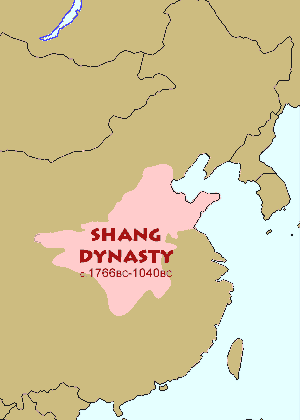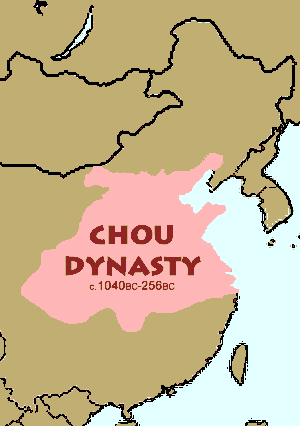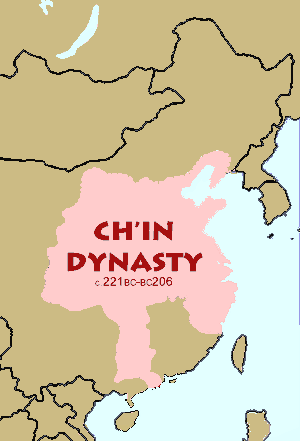 From at least 1766BCE to the twentieth century of the Common Era, China was ruled by dynasties. A dynasty is a ruling family that passes control from one generation to the next. A dynasty does not have to last for a long time. One Chinese dynasty lasted over 800 years, while another lasted only fifteen years.
From at least 1766BCE to the twentieth century of the Common Era, China was ruled by dynasties. A dynasty is a ruling family that passes control from one generation to the next. A dynasty does not have to last for a long time. One Chinese dynasty lasted over 800 years, while another lasted only fifteen years.
The ancient Chinese believed their ancestors in heaven had chosen their leaders. They called this the Mandate of Heaven. The Chinese people often rebelled against a weak leader if they believed he had lost the Mandate of Heaven.
There are indications of an earlier Xia Dynasty (pronounced she-ah*), but the Shang were the first dynasty to leave written records. The Shang Dynasty ruled China from approximately 1766BCE to 1046BCE. Shang rulers expanded the borders of their kingdom to include all the land between present-day Mongolia and the Pacific Ocean.
The Shang practiced human sacrifice. If a Shang ruler died, many subjects would join the ruler in his grave. Some people were beheaded first, but others were buried alive. When a Shang king died, his next oldest brother replaced him. When there were no brothers, the oldest maternal nephew became king. A maternal nephew would be a child of one of the deceased king’s cousins – that is, a son of his mother’s siblings.
 The Zhou (joe*) were nomads who lived west of the Shang. They overthrew the Shang and ruled China from 1046BCE to the third century before the Common Era. The Zhou gained power, in part, from their ability to extract iron from rocks. They used the metal to create powerful weapons.
The Zhou (joe*) were nomads who lived west of the Shang. They overthrew the Shang and ruled China from 1046BCE to the third century before the Common Era. The Zhou gained power, in part, from their ability to extract iron from rocks. They used the metal to create powerful weapons.
The Zhou developed a feudal system in China. In a feudal system, the rulers appoint nobles to control smaller parts of an empire. Zhou nobles divided their land into farms for extended families. An extended family might include many generations and would often include cousins and second cousins. Landholding families were loyal to their nobles, and the nobles were loyal to the Zhou rulers.
The Zhou rulers taxed their subjects, but they used the wealth they collected to build huge walls around their cities to defend the cities from nomadic warriors.
 Nobles gradually gained more power than the Zhou rulers in a period of history historians call the Age of Warring States. It was during this period of instability that a great teacher named Confucius tried to develop good government.
Nobles gradually gained more power than the Zhou rulers in a period of history historians call the Age of Warring States. It was during this period of instability that a great teacher named Confucius tried to develop good government.
Rulers of the Qin (chin*) dynasty managed to unify China and end the Age of Warring States by 221BCE. The Qin rulers clearly explained their laws to the people — and then strictly enforced them. Qin rulers standardized weights and measures and carried out irrigation projects. The Qin also gave peasant farmers the land they lived on. The West first learned of China during the Qin Dynasty. It is from Qin that we get the word China.
A group known as the Legalists influenced the Qin Dynasty. The Legalists believed a powerful leader and a stable legal system were needed to create social order. The Legalists tried to suppress all thoughts that disagreed with their philosophy. People who discussed ideas not approved by the Legalists faced execution. One Qin ruler ordered 460 scholars to be buried alive because the scholars disagreed with the teachings of the Legalists.

The Great Wall of China was constructed across the historical northern borders of ancient China as protection nomads from the steppe. Emereor Shih Huang-ti, who ruled from 220–206 BCE, ordered that smaller fortifications be united into a single wall. Little of the original wall remains because rulers of the Ming Dynasty (1368 – 1644) strengthened the fortification.
China grew into a great empire during the Han Dynasty, between 202BCE and 220CE. Scholars trained in the teachings of Confucius ran the Han governments with great skill. The last Chinese dynasty to rule came from a region of northeast China called Manchuria. The Manchus, also known as the Qing (king*) were weak rulers who could not stop other nations from interfering with China.

The British seized Hong Kong in 1841, but more importantly, by the middle of the nineteenth century, had forced the Chinese government to allow them to sell a dangerous drug called opium to the Chinese people. The British defeated the Manchus in a series of conflicts later known as the Opium Wars.
In 1894, Japan seized the island of Formosa, which later became known as Taiwan. By the turn of the century, foreigners had overrun China. Parts of China were ruled by the British, French, American, German, Russian, and Japanese forces. The Chinese people believed that the Manchus had lost the Mandate of Heaven. They began to support a group known as the Nationalists, who pledged to free China from foreign rule. The Nationalists had driven out the last of the Manchu rulers, a six-year-old boy, by 1911.
Resources
Download this lesson as Microsoft Word file or as an Adobe Acrobat file.
View a Powerpoint presentation of this lesson.
Listen as Mr. Dowling reads this lesson.
Lexile Measure 1000L
Mean Sentence Length 14.72
Mean Log Word Frequency 3.42
Word Count 795
Mr. Donn has an excellent website that includes a section on China.
The Dynasties of China
Xia (c. 2200 – 1766BCE)
Chinese oral tradition describes Yu the Great, who organized the people to build canals that stopped flooding and created great prosperity. Most historians once believed the Xia to be a mythical dynasty, but recent archaeological findings seem to verify their existence.
Shang (1766 – c.1040BCE)
Excavations have confirmed descriptions in ancient Chinese literature of a highly developed culture. In addition to developing a writing system still in use today, the Shang created a lunar calendar of twelve months of 30 days each. The Shang were distinguished by an aristocratic government, great artistry in bronze, an agricultural economy, and armies of thousands whose commanders rode in chariots.
Zhou (c.1040 – 256BCE)
The nomadic Zhou people from northwestern China overthrew the Shang kings. The Zhou developed a feudal society in China but slowly lost power to local warlords.
The Age of Warring States (c.481- 221BCE)
Many regional states formed as the Zhou Dynasty lost the Mandate of Heaven. This is why the Zhou Dynasty overlaps the Age of Warring States for over two centuries.
Qin (221-206BCE)
Weights and measures, and the Chinese writing system were unified under the Qin. Chinese defenses against nomadic warriors were strengthened by creating the Great Wall.
Han (206BCE – 220CE)
During the Han Dynasty, the Chinese invented paper, recorded the history of their land, and first learned of Buddhism. The Han is often compared to the Roman Empire of the same age. Today the Chinese word for a Chinese person means “a man of Han.”
Age of Disunity (220 – 589)
China broke into many regional kingdoms until the nation was reunified by Emperor Wen of Sui.
Sui (581-618)
During Sui rule, a Grand Canal linked northern and southern China.
Tang (618-907)
Considered the “Golden Age of China,” the Tang Dynasty made China the largest, wealthiest, and most populous nation of their time. Tang rulers based their laws on Confucian thought.
Five Dynasties and Ten Kingdoms (907-960)
Several rival states vied for control of China during a brief period of disunity.
Song (907-1279)
The Song Dynasty reunified China and ruled for 300 years. Paper money was introduced during the Song dynasty.
Yuan (The Mongols) (1279-1368)
Kublai Khan established the Yuan Dynasty after Mongol tribes defeated China. The Yuan encouraged Europeans to travel overland to China; Marco Polo was the most famous of the early Europeans to make the journey.
Ming (1368-1644)
As famine and plague swept China, the Mandate of Heaven passed to Zhu Yuanzhang, who led a peasant army to victory over the Mongols. The Ming Dynasty was known for orderly government and control over Chinese peasants.
Qing (Manchus) (1644-1911)
Founded by conquerors from Manchuria in 1644, the Qing was the last imperial dynasty of China. Decades of upheaval led to the fall of the Qing.
The Republic of China (1912-1949)
A series of weak governments followed the fall of the Qing. In 1931, Japan seized Manchuria in northeast China and formed the puppet state of Manchuko.
The People’s Republic of China (1949-present)
A Communist revolution led by Mao Zedong captured control of China in 1949. The communists continued to rule long after Mao’s death in 1976.


